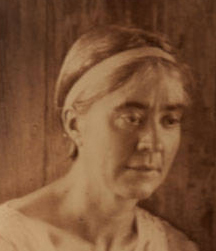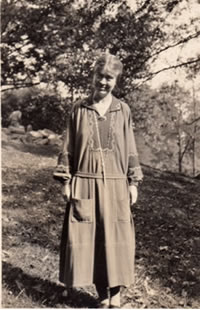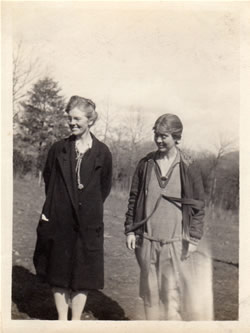The People:
Marguerite Butler Bidstrup
Educated at Vassar College, Marguerite Butler Bidstrup (1892-1982) went to Kentucky’s Pine Mountain Settlement School to teach, and remained there for eight years. Having met John and Olive Campbell at the annual Conference of Southern Mountain Workers, Butler and Olive Campbell began a lifelong relationship focused on education and folk culture after John’s death. Butler accompanied Campbell to Denmark in 1922 where they studied Danish folk schools and, in England, visited with folklorist Cecil Sharp at his folk dance school. After their return in 1925, Butler traveled to Murphy, North Carolina, looking for a place to locate a folk school. Pledging land and labor, local citizens encouraged her to consider their Brasstown as a suitable site. In 1925 the John C. Campbell Folk School was established, with Marguerite Butler as assistant to Director Olive Campbell. In 1926 Georg Bidstrup moved onto the folk school grounds to manage the farm. In 1936 he and Marguerite married and, together, their interest in folk dancing flourished. An obituary from the Asheville Citizen listed Marguerite Butler Bidstrup as a folk dance “caller.”
The following biography is transcribed from The First 40 Years: John C. Campbell Folk School by Pat McNelley.
Marguerite Butler, a young and eager Vassar graduate, first came to the Southern Mountains as a teacher at the Pine Mountain Settlement School in Harlan County, Kentucky. During her eight years in that area, she had abundant use for all the Sociology and Economics she had learned at college, plus all the natural resources of her dynamic personality. At that time roads were trails, in and out of creeks and often the creek bed itself; third grade was the top class at Pine Mountain. What a challenge this was! Her inherent ability as an organizer, her untouched gift as a leader, were put to work. This was a job that required tireless physical energy, especially the last five years, when as extension worker, one of her jobs involved the supervision of eleven one-room schools under the County Superintendent of Schools. On her visits to these little schools, it was often necessary to spend one or two nights on the road. She was always made welcome with true mountain hospitality. Marguerite loves to recall now that, “the only expense I ever had to turn in to the County Superintendent’s office was for the shoeing of my horse.”
This was also her introduction to the “running set”—the mountain of the square dance—all couples in a big circle, the lead-off man always the caller. There was no music other than the rhythm of the dancers’ feet and the clapping of hands. Frequently with certain figures, everyone joined in a little song:
“Killicrankie is my song,
I sing and dance it all day long,
From my elbow to my toe
How much furder can I go.”
She was fortunate to have been present when Cecil Sharp, the well-known English collector of folk songs, saw for the first time at Pine Mountain (on the terrace behind Far House), this running set.
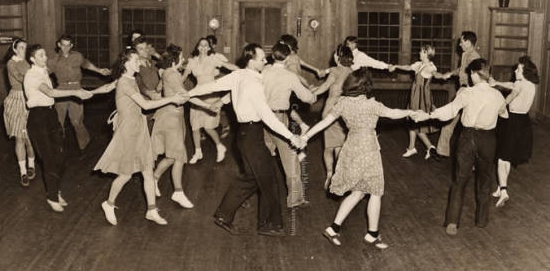
Georg and Marguerite Butler Bidstrup were responsible for folk dance programs at the John C. Campbell Folk School
He wrote to Mrs. Campbell later, “They sing ballads after dinner and grace before it.” The scene is described by him:
It was danced one evening after dark on the porch of one of the largest houses of the Pine Mountain School with only one dim lantern to light up the scene. But the moon streamed fitfully in lighting up the mountain peaks in the background and, casting its mysterious light over the proceedings, seemed to exaggerate the wildness and the break-neck speed of the dancers as they whirled through the mazes of the dance. There was no music, only the stamping and clapping of the onlookers, but when one of the emotional crises of the dance was reached… the air seemed literally to pulsate with the rhythm of the “patters” and the tramp of the dancers’ feet, while, over and above it all, penetrating through the din, floated the even, falsetto tones of the Caller, calmly and unexcitedly reciting his directions.
Pine Mountain and Hindman Settlement Schools, both in Kentucky, had always encouraged the singing of ballads and as a result a wealth of songs were collected.
This was the life of Marguerite Butler when she first met John C. Campbell at an annual meeting of the Conference of Southern Mountain Workers as it was then known in 1919. She had been asked to tell of her work with these eleven widely scattered little schools. At that time such a cooperative project was unique—someone from an independent school cooperating with the county system. So it was that Marguerite Butler was asked to join Olive Campbell in a study of the Folk Schools of Denmark – a study Mr. and Mrs. Campbell had hoped to make in 1914. World War I prevented this and then before conditions were normal in Europe, Mr. Campbell died very suddenly in 1919. They spent a year in Scandinavia, followed by two months in England and Ireland to see something of the adult education movement there. It was while living at the various Danish Folk Schools that Marguerite first became acquainted with the lively folk dances. This opportunity to see and learn the various dances and singing games has enabled her to make an outstanding and valuable contribution to the recreation movement in the Southern Highlands. Many of our American square figures are common in the Danish dance.
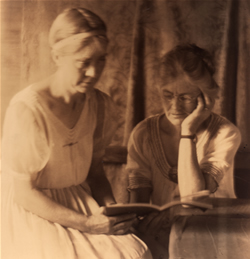
This was the background which Marguerite Butler brought to the John C. Campbell Folk School when it was established in 1925. For these forty years she has shared her wealth of experience as an administrator and teacher, her love of the folk ways and dances, and has steadfastly maintained her confidence and respect for the stalwart character of the people of Appalachia.
- Transcribed from Pat McNelley,
The First 40 Years: John C. Campbell Folk School
(Atlanta: McNelley-Rudd, 1966).
Used with permission of the John C. Campbell Folk School.
